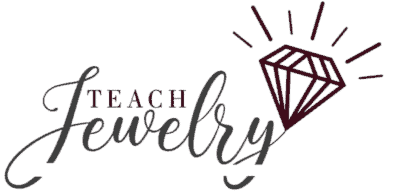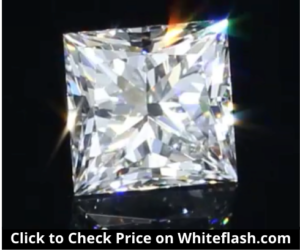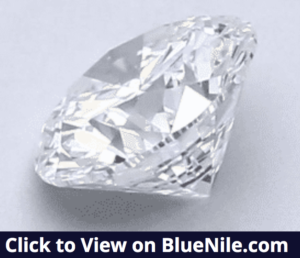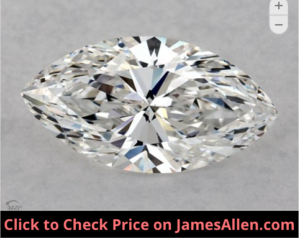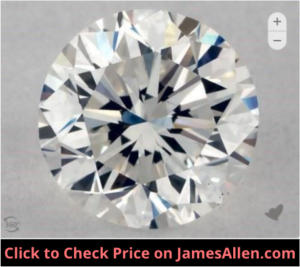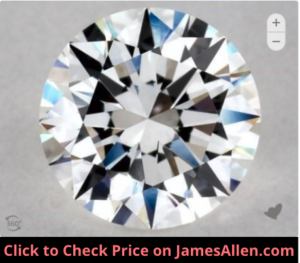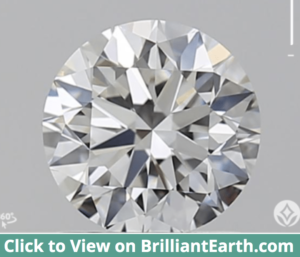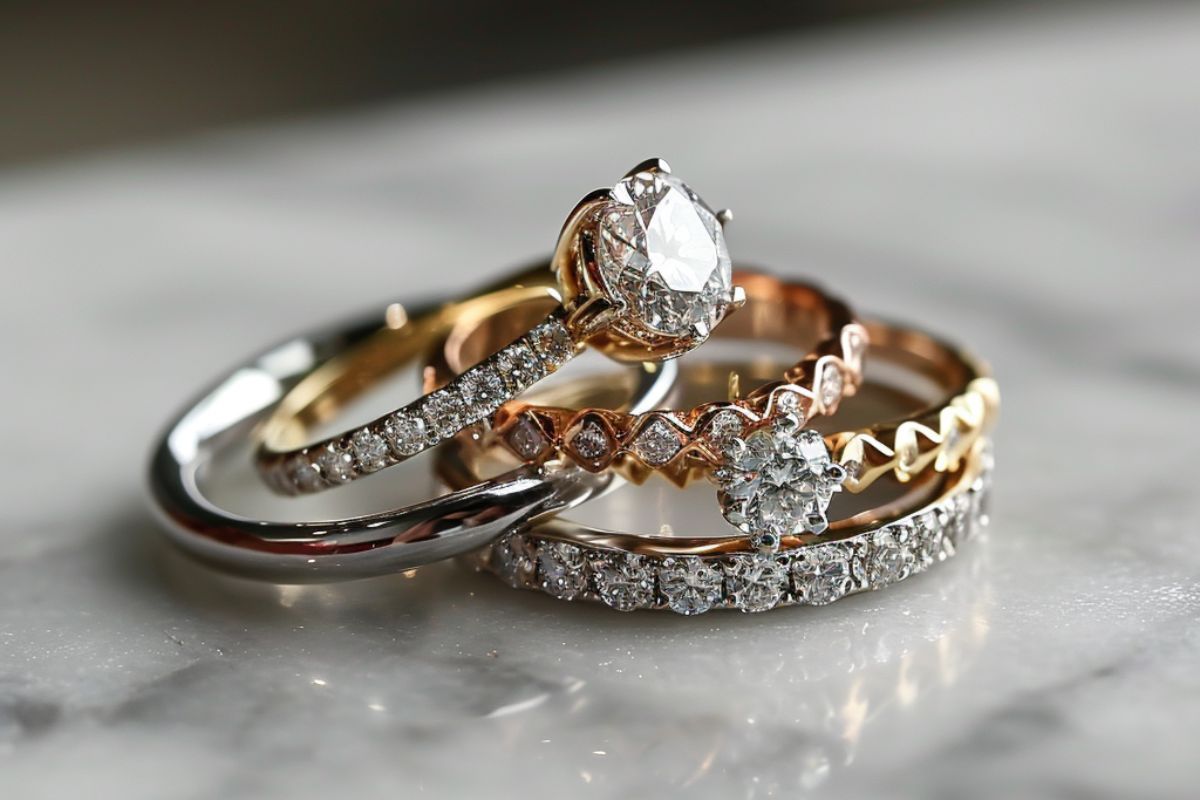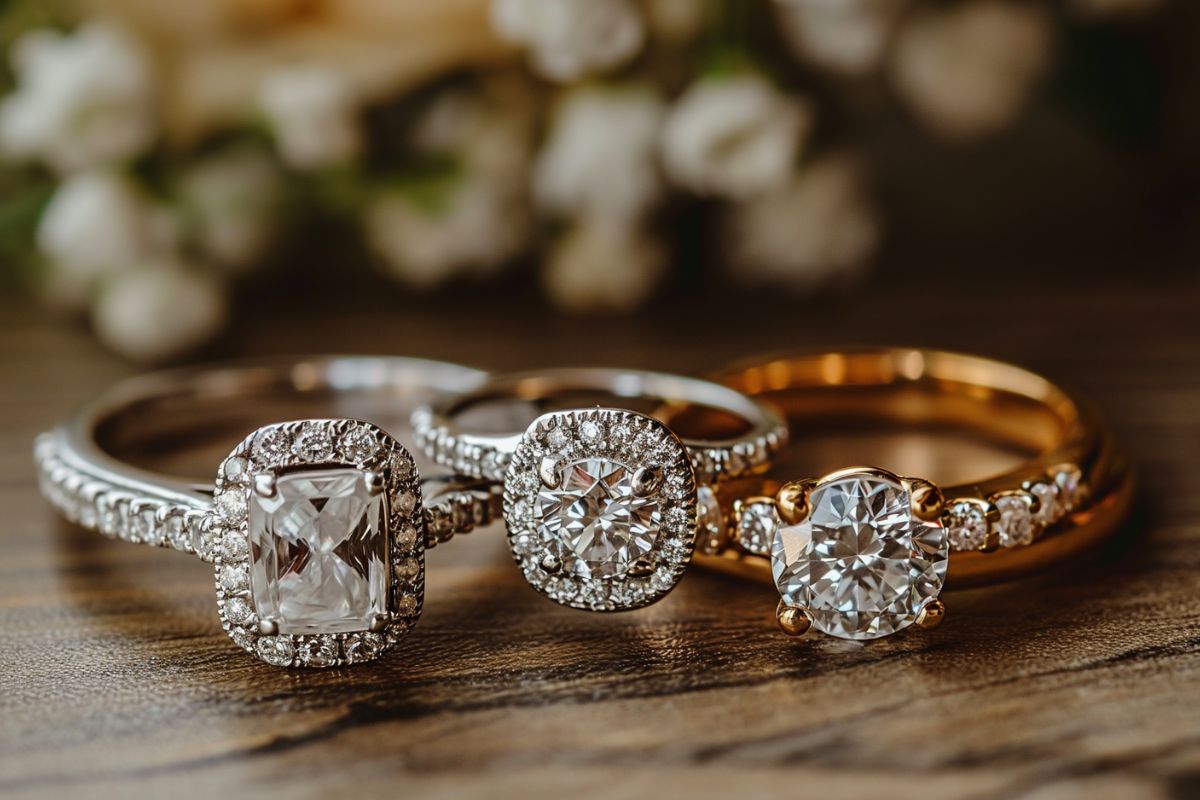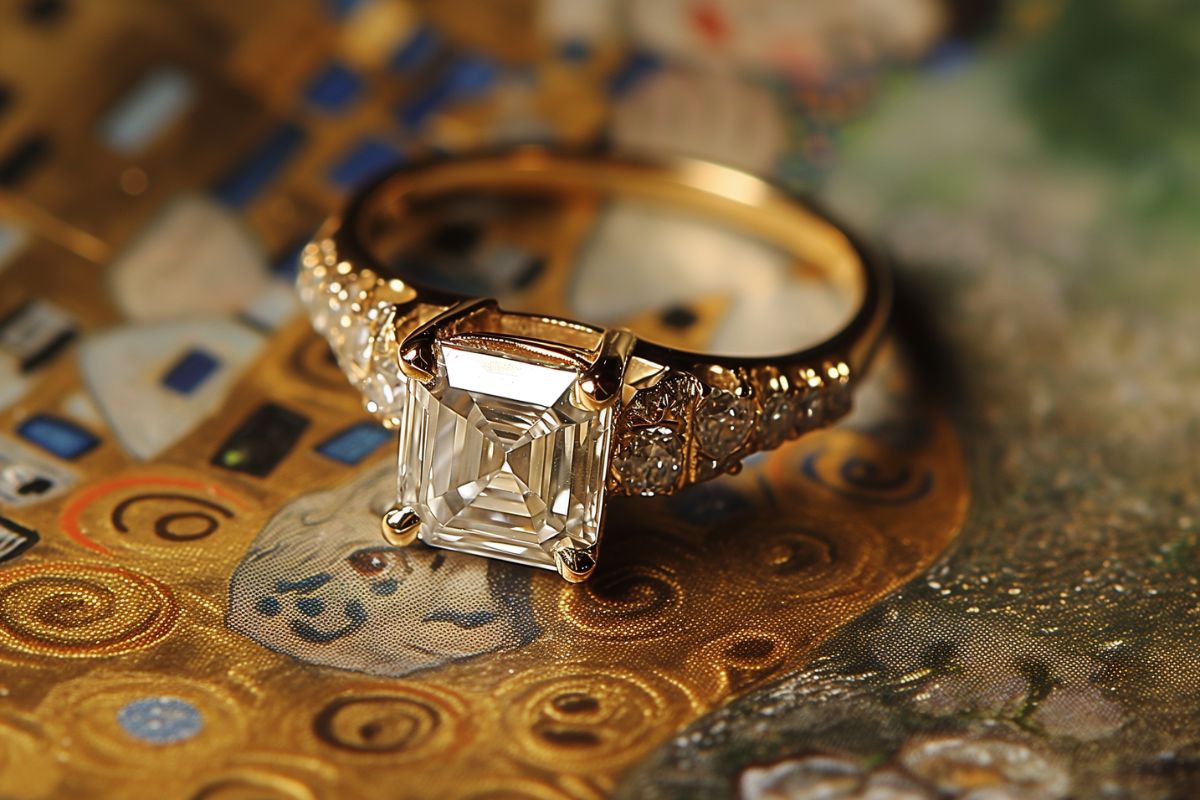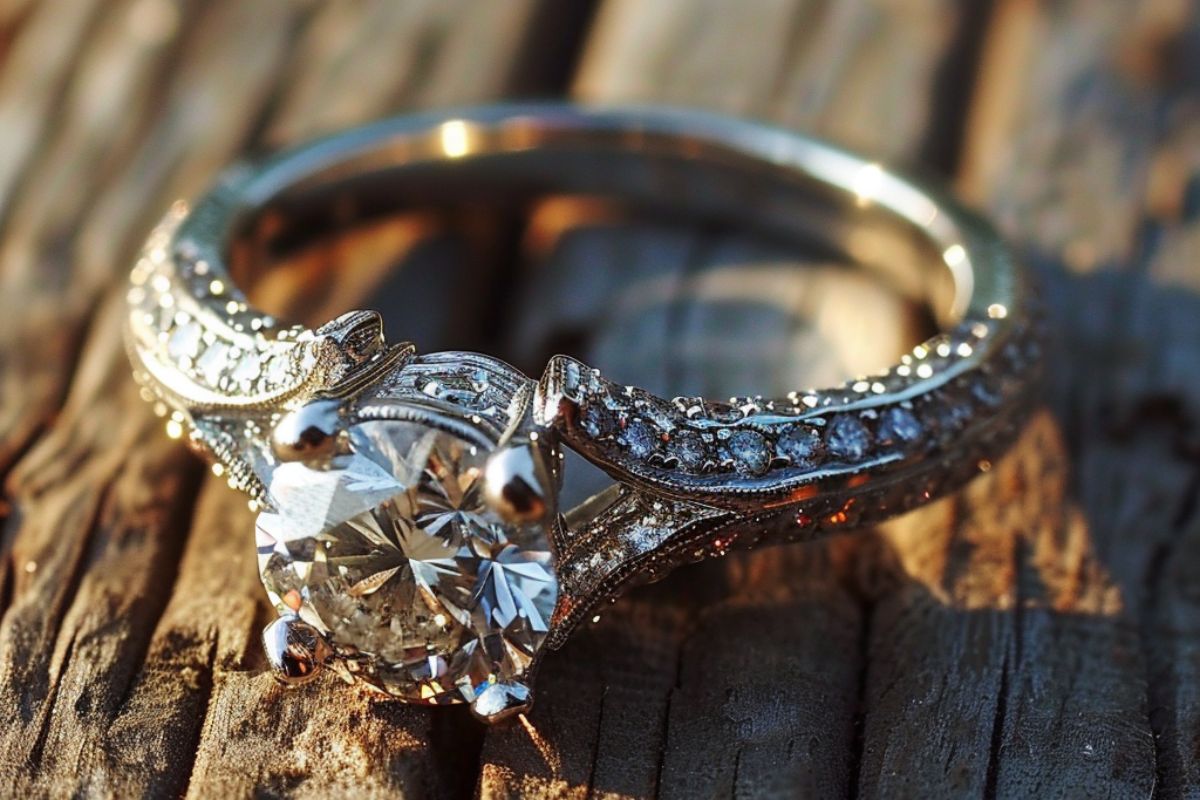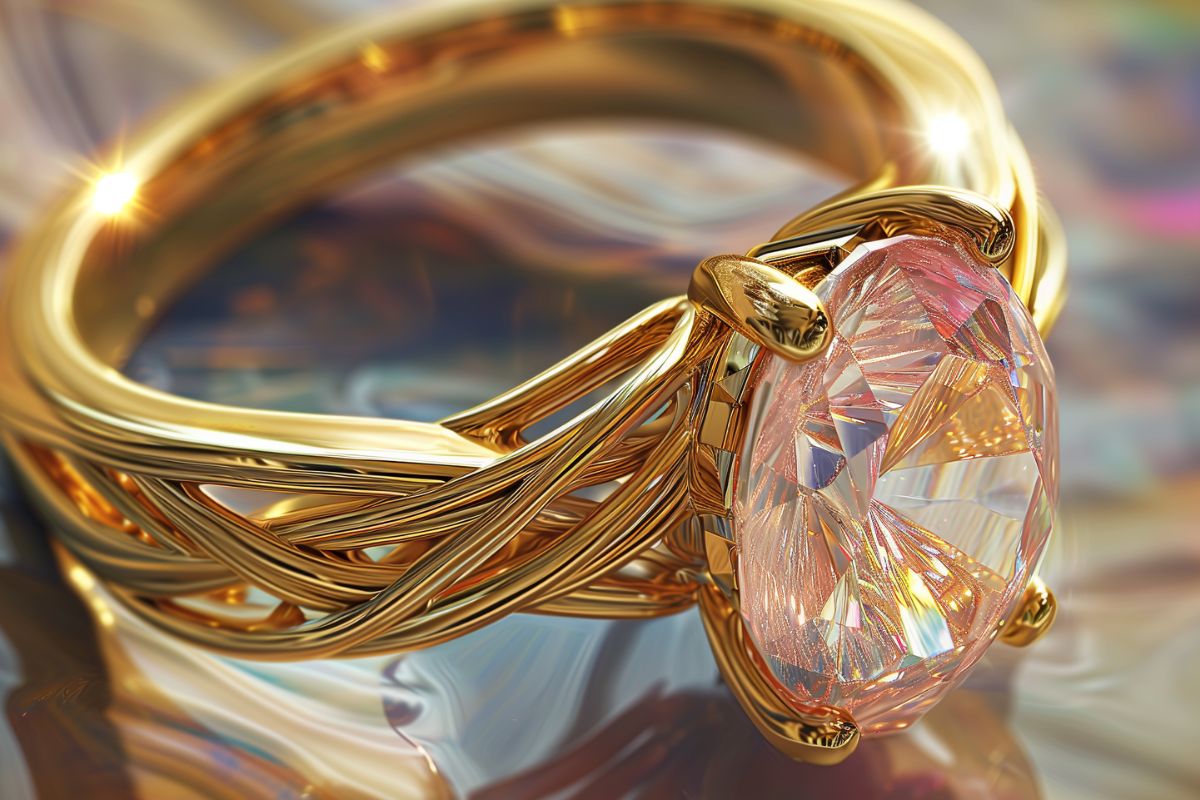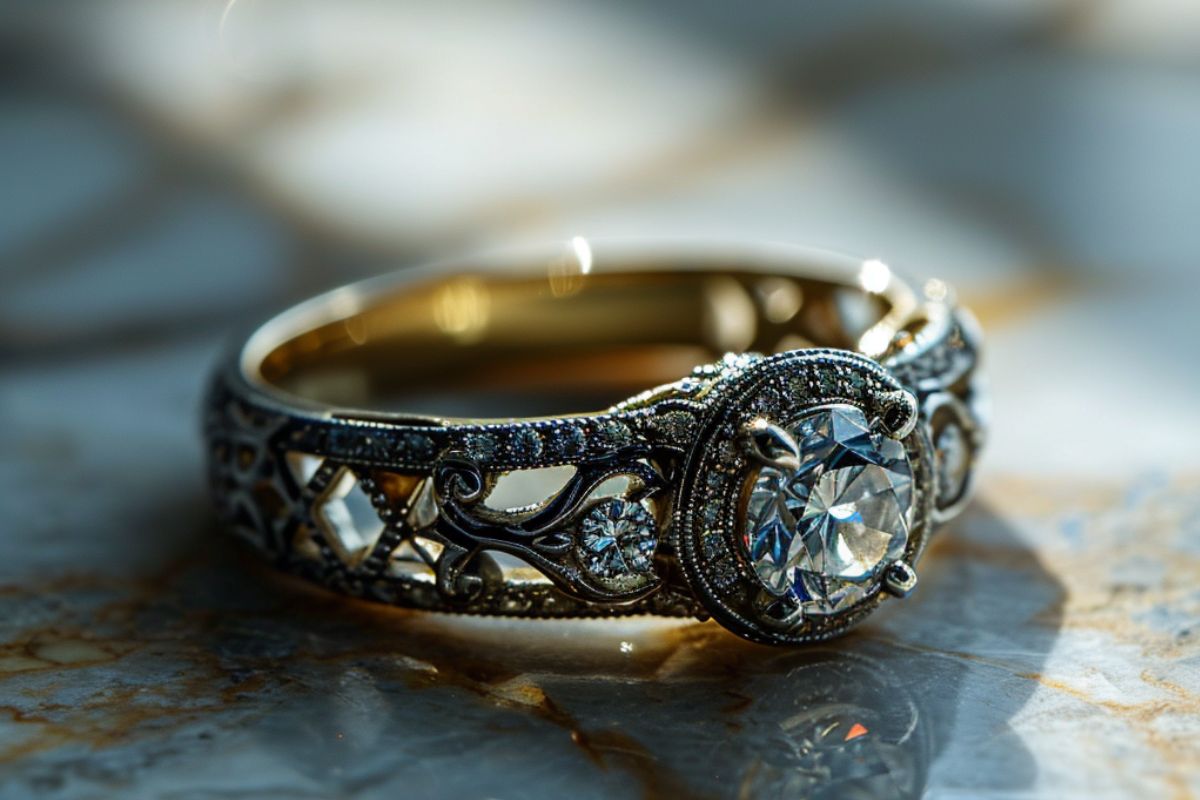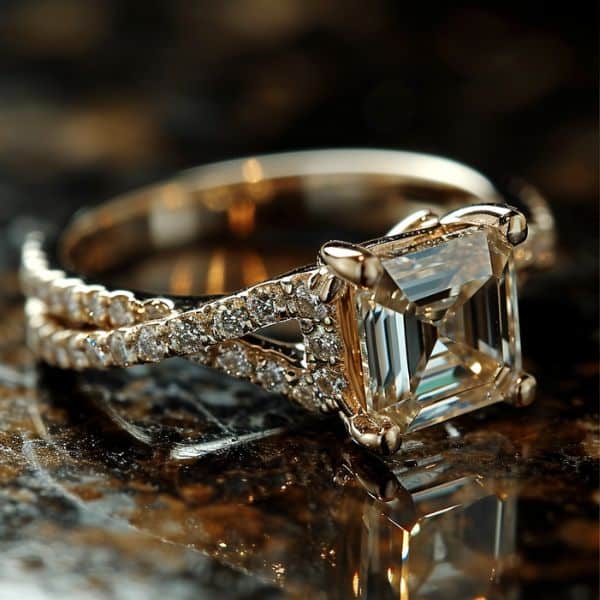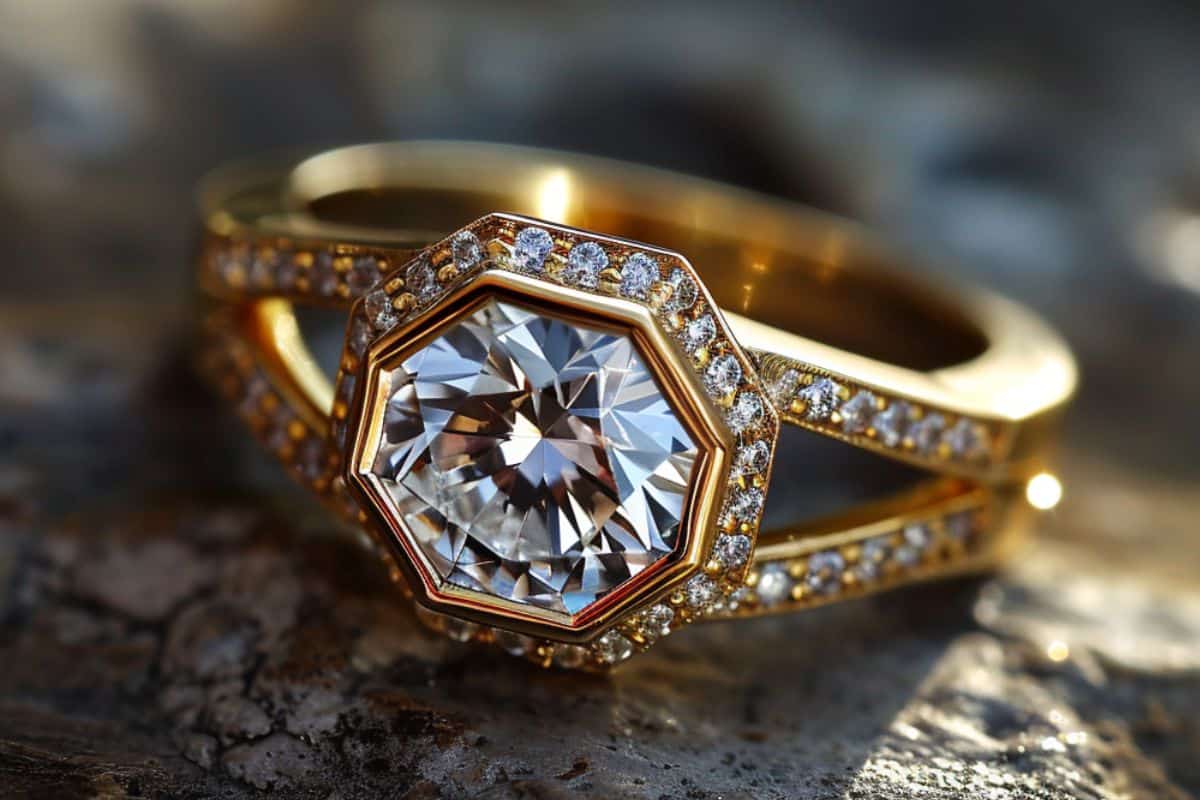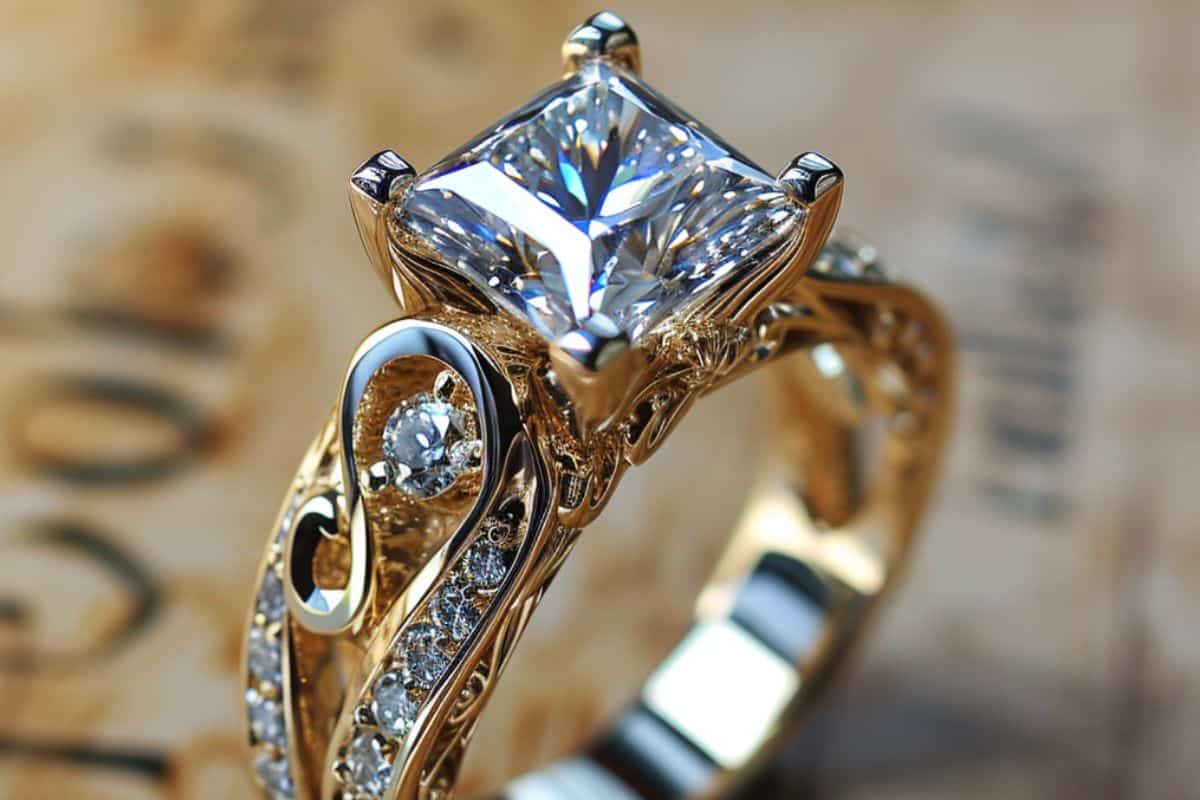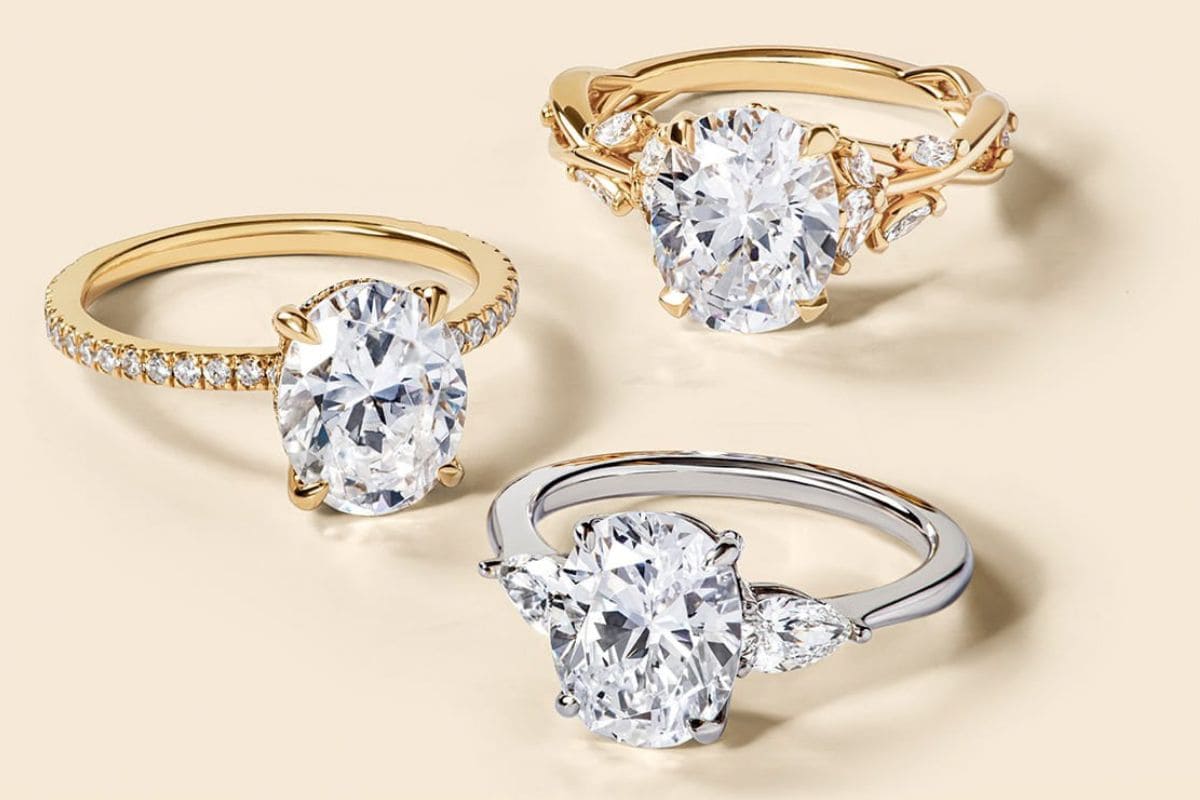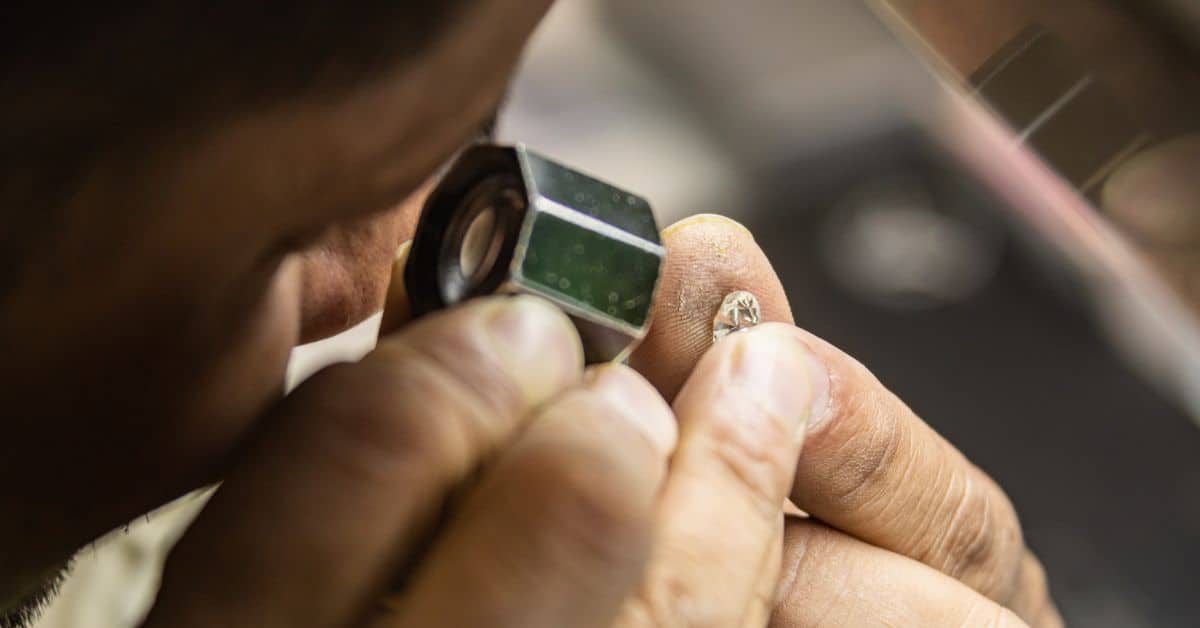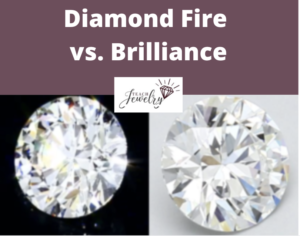
In addition to the four Cs of color, clarity, cut, and carat, there are two other traits of a diamond worth exploring.
Fire and brilliance both involve the way light interacts with its facets, but the two are distinct qualities.
The main difference between diamond fire and brilliance is fire refers to the colored flashes of light that radiate from a diamond when it’s twirled, while brilliance is the white light that sparkles from its facets. Some diamonds have fire or brilliance, and some have a combination of the two.
We’ll compare fire versus brilliance, the factors that cause diamonds to display these characteristics, and how you should prioritize them in selecting the right one for you.
What is Diamond Fire?
A diamond’s fire is the colored flashes of light that disperse from its facets. White light enters the diamond, and it’s broken into the individual colors in the spectrum.
Check out the image below of a princess cut exhibiting strong fire.
When you rotate the image, you’ll notice colored streaks shining from all its facets.
Also called light dispersion, diamond fire results in a small rainbow of colors exuding from the gem when it’s twirled.
There are many wavelengths that combine to form white light. Whenever light enters a substance, those wavelengths slow down.
In a diamond, light refracts and then speeds up when it exits.
The diamond acts as a prism that interacts with those wavelengths in different ways.
Because the wavelengths bend and refract at unique rates, they separate from each other. For the viewer, this results in a rainbow of colors such as orange, blue, yellow, and green.
What is Brilliance?
Brilliance refers to the white light reflected from a diamond. It’s the glimmer a diamond exhibits when it’s rotated under light.
Here’s a round-cut diamond that showcases strong brilliance.
Even in the photo, you can identify how some of its facets are collecting and reflecting white light.
Brilliant diamonds are cut in a way to maximize the amount of white light they collect and return to the viewer without leaking it through other facets or the culet.
Poorly cut diamonds have less brilliance because light doesn’t travel through the diamond at the right angles for it to return without distortion.
It’s one of the most valued traits in a diamond, which has inspired a full line of brilliant cut diamonds such as round, princess, marquise, and pear cuts.
For example, here’s a marquise cut that shows brilliance.
On the vendor’s website, click the image to allow it to rotate 360 degrees. You’ll notice the facets appear to turn on and off with light.
Which Factors Impact Fire and Brilliance?
Proportions
The proportions of a diamond are the size of its depth, width, and table and the ratios between those measurements.
Ideal proportions allow a diamond to collect and reflect the most light, which contributes to its brilliance and fire.
For example, ideal proportions for round brilliant cuts are around:
- Depth: 59%-63%
- Table: 54%-57%
- Crown angle: 31.5%-36.5%
- Pavilion angle: 40%-42%
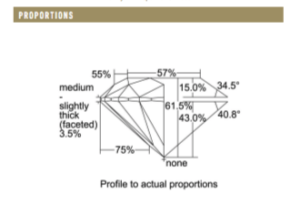
A small culet and thin to slightly thick girdle also contribute to ideal proportions for fire and brilliance.
A diamond that’s too shallow or deep won’t exhibit strong fire. Light leaks out of its sides and doesn’t return to the viewer.
This can result in a dull appearance that doesn’t shine even under bright lights.
The exact percentages for ideal proportions differ between cuts. Proportions for emerald cuts differ from baguette cuts, and pear cuts are unique from marquise diamonds.
Pay closer attention to proportions for those fancy shapes because they don’t receive a cut grade from the GIA. You’ll have to rely on proportions and other measurements to determine its degree of fire and brilliance.
Polish and Symmetry
The polish of a diamond refers to the smoothness of its facets. Diamond cutters manufacture specific cuts with a polishing wheel that may create small surface defects.
Not only can these flaws diminish its visual appearance, they also impact how light interacts with diamond.
Rough areas on facets prevent light from properly entering the diamond and exiting as colored or white light.
The same idea is true of diamond symmetry, which measures the alignment and shape of facets.
If facets aren’t symmetrical, light distorts in the diamond and can leak through the pavilion or reflect in too many directions.
Other issues related to symmetry that lessen a diamond’s fire and brilliance are:
- The table is off-center
- The culet is off-center
- The crown and pavilion are misaligned
If your diamond has a grading report from the GIA, view the quality of its symmetry and polish in the “Additional Grading Information” section.
I’ve posted an example below of a diamond that earned excellent grades for both.
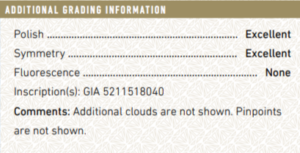
If it earns those grades, you can have confidence the polish and symmetry won’t reduce its brilliance or fire.
Cut
The quality of a diamond’s cut includes its proportions, polish and symmetry, and other factors. It’s the most important of the four Cs in determining the fire and brilliance of a diamond.
No matter the size or shape, a poorly cut diamond will appear dull.
Light will leak from the pavilion or exit the diamond in several directions, reducing the amount returned to the viewer.
The GIA gives diamonds the following cut grades:
- Excellent
- Very good
- Good
- Fair
- Poor
If you’re looking for a diamond with the most brilliance and fire, choose an excellent cut grade.
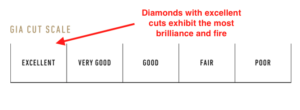
Here’s an example of a diamond with a “good” cut grade.
Based solely on the photo, it’s hard to distinguish it with this diamond, which has the same grades across the other three Cs of color, carat, and clarity but earned an excellent cut grade.
That underscores the importance of choosing a diamond with a reliable grading report.
For fancy shapes that don’t receive a cut grade from the GIA, ensure its proportions, polish, and symmetry align with those of well-cut diamonds.
Clarity
The clarity of a diamond is graded on the presence of inclusions.
Inclusions are flaws in a diamond that developed during its formation or while it was cut from the rough diamond.
To illustrate, the diamond on the left is full of inclusions, and the one on the right is clean.
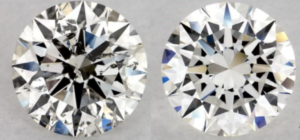
There’s an obvious difference in their visual appearance, even if you don’t take into account fire and brilliance.
Examples of clarity characteristics include indented natural inclusions, twinning wisps, and cavities. Some are large enough that they’re visible to the naked eye, while others can only be seen with magnification.
Either way, they have the potential to diminish a diamond’s fire and brilliance because they distort the way it interacts with light.
When light hits a dark spot on a diamond, a white feather, or a cavity, it doesn’t reflect back properly.
A diamond full of inclusions will appear dull because of its poor light performance. You can minimize their impact by selecting one with small, transparent inclusions.
These diamonds are often graded a VS2 or above on the GIA clarity scale.
Choosing a diamond with an excellent cut grade and one where inclusions are only visible with magnification can help you avoid issues with its fire and brilliance.
Type of Light
The type of light hitting a diamond affects its light performance.
LED lights create more fire in a diamond than fluorescent light. So diamonds often display significant fire in indoor settings.
When they’re placed under LED lights, you can notice a diamond’s fire even from several feet away.
The opposite is true for brilliance. A diamond’s brilliance is best displayed under fluorescent light.
When you’re exploring diamonds at a jewelry retailer, they’ll often allow you to view the diamond under both LED and fluorescent lights.
Take this opportunity to see how it performs in these settings.
If you’re purchasing a diamond online, view high-quality images and a 360-degree video, like the example below.
This gives you an idea of its light performance, but the test is more effective with the diamond in hand.
Also determine how a diamond appears in natural lighting. Jewelry stores set up their lights in a way to showcase fire and brilliance, so understand how it’ll look on a day-to-day basis.
Cleanliness
The cleanliness of the diamond also affects fire and brilliance.
A diamond covered in dirt or debris won’t appear brilliant or exhibit fire. Particles prevent light from entering the diamond.
Clean your diamond by soaking it in water combined with a few drops of mild dish soap. Gently brush it with a soft toothbrush.
I also recommend having your diamond professionally cleaned at least once per year. This ensures grime doesn’t accumulate in a way that will affect its fire and brilliance.
Which Cuts Have the Most Fire?
Some diamond cuts display more fire than others because of the shape and size of its facets.
No cut rivals the fire from a round brilliant cut.
It’s triangle and kite-shaped facets are designed for the best light performance, which is one reason they’re the most popular cut for engagement ring diamonds.
There are also fancy shapes that produce strong fire. One of the pros of princess cuts, cushion cuts, and radiant cuts is their fire.

It’s an effective way to pay a lower price per carat compared to round brilliants but still have a glimmering diamond.
Examples of diamonds that don’t prioritize fire are ones with step-cut facets such as emerald, Asscher, and Carré cuts.
Notice the lengthy facets on this emerald cut.
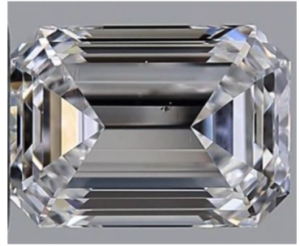
They’re distinct from what you’ll see on a brilliant cut.
The elongated facets don’t allow as much light to enter, bounce around, and reflect out of its facets.
Which Cuts Have the Most Brilliance?
Diamonds with the most fire often have the most brilliance as well.
Round brilliants display the most white light off its facets, followed by:
- Princess
- Oval
- Marquise

The facets of those three cuts have many traits in common with round brilliants but offer an alternative shape to the traditional round diamond.
If you want a square-, oval-, or eye-shaped diamond, you don’t have to sacrifice all its white light.
Pear- and heart-shaped diamonds also have brilliant cut facets conducive to collecting and reflecting light.
If brilliance is a priority for your diamond, explore the diverse shapes of brilliant or modified brilliant cuts.
How do Fire and Brilliance Determine a Diamond’s Scintillation?
When someone describes a diamond’s light performance, they’ll often use the terms fire, brilliance, and scintillation.
Each is describing a unique feature.
Scintillation, also called sparkle, refers to the way both white and colored flashes radiate from a diamond when it’s twirled.
Here’s an example of a diamond showcasing scintillation.
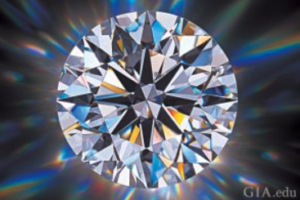
The motion creates the appearance of facets turning on and off.
Research by the American Gem Society demonstrates how sparkle is a result of flash and fire scintillation. The flashes are sparkling white light, and the fire is made up of colored light.
A diamond with a quality cut and strong fire and brilliance will often have a high degree of scintillation.
Is Diamond Fire or Brilliance More Important?
They’re often referred to interchangeably, but compare diamond fire versus brilliance as two separate features.
To learn which is most important to you, view diamonds in person or online that have fire and brilliance, including ones that lack one or the other.
By isolating the qualities, you’ll learn how it changes the appearance of a diamond.
Round cuts have the most fire and brilliance, so place them next to fancy shapes to see which option is right for you.
You may decide improved light performance isn’t worth giving up your choice of a fancy shape.
Either way, you’ll have a diamond with the right amount of fire and brilliance for you.
Beyond the Basics: Fire and Brilliance Q&A
Q1: How does a diamond’s color grade affect its fire and brilliance?
A1: The color grade of a diamond primarily refers to the presence of color or tint in the diamond, which can potentially impact how the fire and brilliance are perceived. A diamond with a higher color grade (closer to colorless) may allow for clearer and more vibrant displays of fire and brilliance as there’s less color to interfere with the light paths.
Q2: Are there any specific diamond treatments that can enhance its fire or brilliance?
A2: Treatments like High Temperature Annealing can sometimes enhance the color and clarity of a diamond, potentially impacting its fire and brilliance. However, treatments may not always be permanent and can affect the diamond’s value.
Q3: How do inclusions and blemishes affect a diamond’s fire and brilliance?
A3: Inclusions and blemishes can disrupt the path of light as it travels through a diamond, which can consequently diminish both its fire and brilliance. Choosing a diamond with fewer or smaller inclusions (a higher clarity grade) can help maintain a diamond’s light performance.
Q4: Does the size of the diamond have an effect on its fire and brilliance?
A4: Larger diamonds have a bigger surface area and more facets which can potentially display more fire and brilliance. However, the cut quality is the primary determinant of a diamond’s fire and brilliance, regardless of its size.
Q5: How does the setting of a diamond engagement ring affect the diamond’s fire and brilliance?
A5: The setting can affect how light interacts with the diamond. For instance, open settings like prong and cathedral settings allow more light to enter the diamond, potentially enhancing its fire and brilliance, while bezel settings might restrict light entry to some extent.
Q6: Can different lighting conditions change the appearance of fire and brilliance in a diamond?
A6: Absolutely, LED lights tend to enhance a diamond’s fire while fluorescent lights may showcase a diamond’s brilliance better. The appearance of fire and brilliance can change dramatically under different lighting conditions.
Q7: How does the material of the jewelry setting (e.g., white gold, yellow gold, platinum) affect a diamond’s fire and brilliance?
A7: The material of the setting can reflect light in different ways. For instance, a white gold or platinum setting might reflect more light into the diamond, potentially enhancing its brilliance, while a yellow gold setting might add a warm hue to the diamond, possibly affecting the perceived fire and brilliance.
Q8: Are there any new cutting techniques that have been developed to enhance a diamond’s fire and brilliance?
A8: Advancements in cutting technology and techniques continue to emerge aiming to maximize a diamond’s fire and brilliance. Precise computer-aided design (CAD) and laser cutting are examples of modern techniques that allow for more exact facet arrangements to enhance light performance.
Q9: How do fluorescence and phosphorescence in a diamond affect its fire and brilliance?
A9: Fluorescence can cause a diamond to glow under ultraviolet light which can sometimes enhance the color of diamonds with a yellowish tint, potentially affecting the perception of fire and brilliance. Phosphorescence, on the other hand, is a rare quality that could cause a diamond to glow in the dark after exposure to light, which doesn’t directly affect fire and brilliance but can be a unique feature.
Q10: Is there a way to quantitatively measure a diamond’s fire and brilliance or is it subjective?
A10: While there are certain tools and metrics used within the industry to measure aspects of fire and brilliance, the perception of these qualities can be quite subjective and may vary from person to person. Viewing diamonds in different lighting conditions and settings can help individuals determine their personal preferences regarding fire and brilliance.

Jacob Clarke
Jacob Clarke is the founder of TeachJewelry.com.
He earned an Applied Jewelry Professional Diploma from the Gemological Institute of America (GIA) and now brings you essential information about diamonds, settings, and more.
Jacob has consulted with leading jewelry brands, and his work has been cited in Clean Origin, Diamond Nexus and industry publications.
He's also a member of the International Gem Society.
He enjoys discussing jewelry with readers, so contact him with any questions at jacob.clarke@teachjewelry.com.
